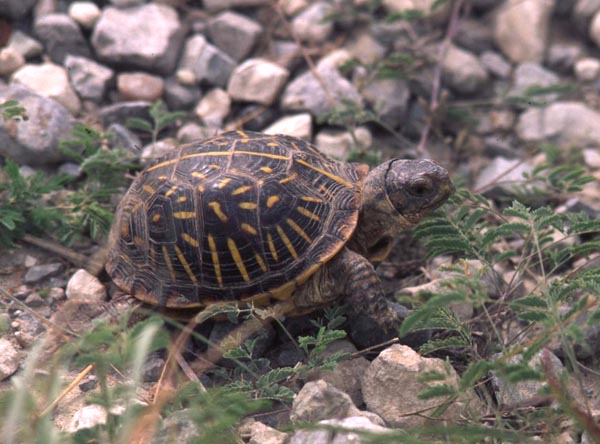

The ornate box turtle is common throughout much of the south-central
Great Plains of the US, from Nebraska and southern South Dakota, through
Kansas, Oklahoma, and practically all of Texas. In the east it ranges into
much of Missouri, western Arkansas, and southwestern Louisiana, and in
the west it reaches eastern Colorado and eastern New Mexico. A western
subspecies, the Desert box turtle, occurs in southern New Mexico, southern
Arizona, and northwestern Mexico. The ornate box turtle, however, does
not cross the Rio Grande into Mexico (thus the river forms a geographic
barrier to its dispersal).
The ornate box turtle and the three-toed box turtle are sympatric across much of their respective ranges; these two species differ from one another in a number of characteristics. The ornate box turtle has a pattern of yellow stripes and blotches on a dark background. This pattern is on the plastron as well as the carapace. The ornate box turtle has four toes on the hind feet, and the inner toe and claw can be turned inward and are used to help males hold their position during mating. The carapace of ornate box turtles is flattened relative to that of three-toed box turtles, which is usually domed and may have a mid-dorsal ridge. The ornate box turtle never has a mid-dorsal ridge. The ornate box turtle is similar in size to the three-toed, adults averaging about 10-12 cm in length, with records over 15 cm. Females are somewhat larger than males, and as in the three-toed, males have orange or red eyes and markings on the neck and front legs. Females lack these colorful markings.
The ornate box turtle is an inhabitant of prairies and savannas. In the eastern parts of its range it is found in open areas, even those surrounded by wooded habitats. The three-toed of course prefers the woods to the prairies, so these species differ in habitat preferences as well as morphology. Because the ornate box turtle is more often exposed to hot, dry conditions (and lives in places with little shade) it is physiologically better adapted to withstand heat and drought than the three-toed. Like tortoises of the desert, the ornate box turtle stores water in the urinary bladder, and in times of water stress can extract much of the water from the urine, forming a dense, dark urine. It also practices behavioral thermoregulation, burrowing in loose or sandy soil to escape the heat.
Ornate box turtles overwinter in burrows that may be up to 18 inches deep in sandy soil; they may also enter the burrows of other animals (badgers, skunks, armadillos) to overwinter. They emerge in the spring with warm days and rain. Mating typically occurs in the spring but may also occur in the fall (and because egg-laying usually occurs in the early summer, fall mating may mean that females can store sperm). Ornate box turtles are more carnivorous than the three-toed, and prefer insects and soft-bodied invertebrates (worms, crayfish), but they will also eat fruits and berries. Ornate box turtles have a home range of about 5 acres, but the home ranges of several individuals may overlap.
Although details of their phylogeny are not available, the species of
Terrapene
in North America may exemplify allopatric speciation in a continental setting.
They exhibit the typical pattern of one eastern species and one western
species (although in this case with considerable geographic variation in
each species), with divergence between the species in a variety of morphological,
physiological, and behavioral characteristics. These species currently
have broadly overlapping geographic ranges, and are sympatric throughout
much of the western part of the range of the three-toed and the eastern
part of the range of the ornate.